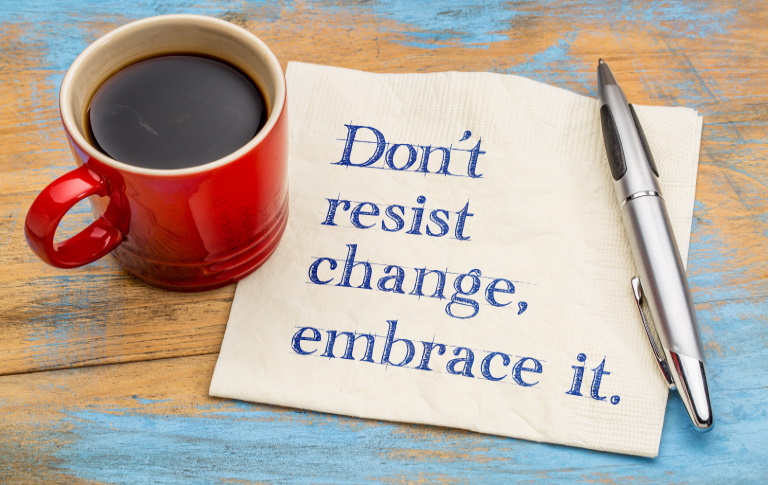Recently we posted a blog discussing change resistance and how we can ‘transform transformation’. In exploring Jim Hemerling’s 5 Imperatives of Change, we addressed the core theme that ran throughout: The idea of putting people first.
When we talk about making changes to an organization, we might use terms like ‘change management’, ‘organizational change’, or ‘organizational transformation’, but the underlying meaning is basically the same: To take a structured approach to transformation and change.
While none of us are strangers to change, each of us responds to it differently. It’s this mixed bag of reactions that is one of the ultimate challenges organizations face when planning and navigating change. It’s also one of the reasons why leadership has such an influential role to play in the success (or not) of any organizational change.
A crucial aspect of change management – the long-lost (and long-neglected) sibling of this process – is change adoption.
And no, we’re not talking about the Angelina Jolie kind of adoption. This kind is of adoption asks people to embrace the intangibles, like a concept or a behavior. To be fair, any kind of adoption is about welcoming something new into our lives. It’s a process that takes time and a level of care and attention before we can fully integrate it in our minds, our hearts, and our workplaces.
Change adoption
So how do change management and change adoption fit together? Well, if change management is taking a structured approach to transformation and change, change adoption is about understanding what has changed and learning to accept it. Change adoption is the process of taking proactive steps to helping your staff adapt and making change stick.
We can break change down into different types or themes. Some common examples are technological, cultural, and structural. The common denominator for all change is that it affects people (there’s that ‘putting people first’ axiom again), so any change management and adoption plans you develop need to reflect that. And leadership is just as important in adoption phase as it is in the management phase.
Hit or miss?
Often, when a change misses the mark, it’s not due to poor implementation, but poor adoption. A carefully planned change management process will always consider the period immediately after implementation and beyond. Make sure yours includes a plan for making change stick.
How often have you seen a change happen, where things went well to begin with, but then over time regressed? Perhaps old behaviors started to creep back in, or people sidelined key steps in the process “because it’s quicker right now”.
Prosci, a self-confessed team of “global change fanatics” refer to this as a lack of reinforcement. ‘Reinforcement’ is the final step of Prosci’s ADKAR methodology. This reinforcement – another way of saying ‘adoption’ – remains a focus, thus ensuring change is embedded in the organisation over the longer term.
How can we make change stick?
Thankfully, there are ways to boost our chances at making change stick. Our change boffins at Prosci have even come up with a series of tactics to help organisations reinforce their changes.
- Publicly visible performance scoreboards can show your team’s compliance to a new process, reinforcing the new behavior or practice.
- Give employees feedback, including saying “thank you”.
- Visible recognition from senior level sponsors.
- Project-sponsored celebrations for employees.
- Design compensation and appraisal systems that support the change.
(Did you notice that many of these tactics are top-down oriented? Cue leadership impact again.)
Here are a few other tactics you might want to consider.
- Make sure you’ve got strong leadership, stakeholder and business engagement. Your leaders need to be aligned to the vision and personally motivated to see it happen and succeed.
- Foster a culture of continuous improvement. Change isn’t just “one and done”. It’s an opportunity to evolve and grow – for your staff and leadership team as much as your business.
- If you’re giving people something new, throw out the old. Remove any temptation or ability to fall back into old habits and procedures.
Power up your policy and procedure adoption process with Way We Do
At Way We Do, we know our customers are often running their own mini-change projects. After all, our very first interactions with new Way We Doers is helping them implement our platform in their business!
It’s important to remember when you’re reviewing, writing or refining your policies and procedures, you’re also going through change, and it’s something you still have to manage.
So how does Way We Do help you make sure your business changes stick? I’m so glad you asked…
Active criteria
Active criteria – the icons down the side of a procedure or checklist – are the features that bring your content to life. When used well, some of these can help make sure your staff embrace Way We Do as part of their working life.
- Add Responsibilities: This creates awareness around what policies, procedures and checklists are relevant to which role, clarifying tasks for your team.
- Create repeatable processes with Schedules & Tasks: If your team don’t know when they’re meant to be doing something, it will have an adverse effect on their ability to adopt new procedures and processes. With Schedules & Tasks, you can set due dates for different actions so they’re not left guessing.
- Set up Procedure Acceptance: A quick and easy way to let your staff know about a new or updated policy, procedure or checklist is to send them a notification, which they then have to acknowledge by accepting it. The added bonus is that you can see what they’ve seen and accepted, and what they still need to get to.
Create an enjoyable experience
An integral part of adoption is creating an ongoing positive and enjoyable experience for your team. The usability and look and feel of your Way We Do account can directly influence this.
- Labeling: As you’re building up your Way We Do account, always keep in mind where things should go. Labels are one of the tools your team will use to browse and explore the platform, so think about it from their perspective.
- Procedure Tiles: These are a nice, visual way to round out your account. As well as making sure you’ve got well-worded titles and descriptions, consider including your brand colors, or even graphics. It adds a sense of completion, that the content they’re looking at is “here, current, and for me”.
Some quick-fire tips for successful change and adoption
Here a few final suggestions to help you get the best results from your change and adoption activities.
- Beat “The best laid plans of mice and men” adage and create a plan for how you’ll deliver your next change and its adoption.
- Always (and I mean always) keep your team at the heart of your plan.
- Communicate, communicate, communicate (then communicate some more).
- Remember! Change doesn’t end with the implementation. Keep the future in mind.
- Make it enjoyable.
Got something to add?
What has your experience of organizational change been in the past? Can you recall any that would have been so much more successful if they had a solid adoption plan? Join the discussion by adding your comments below.





